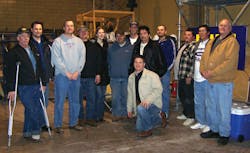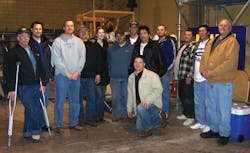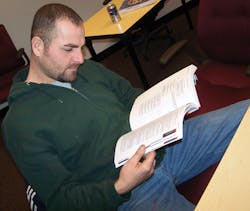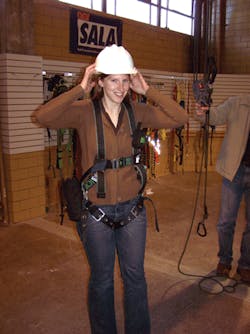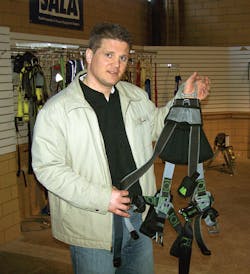Let’s face it. As a writer, I’m more likely to suffer from carpal tunnel syndrome than a fall or electrical hazard on a construction site. My experience with this industry is limited to watching buildings go up from afar and casually noting the PPE choices of the construction workers I pass on the streets of Cleveland.
But I don’t need to be a construction worker to know that safety training in this field – and in general industry as well – can be vital to the health and safety of workers. That’s why I traveled to the Chicago area at the end of January to take the OSHA 10-hour safety training at the Construction Safety Council (CSC).
While I attended the construction course, many of my experiences will translate to general industry, as well. The bottom line is that absorbing even a few hours of basic safety training can prompt workers to realize that if they don’t take certain precautions, they could end up injured – or worse.
Day One
I arrived at the CSC headquarters in Hillside, Ill., on a chilly day at the end of January and joined a dozen other participants in the OSHA 10-hour classroom. As the only woman and the only person in the room who hadn’t spent time working on a construction site, it was clear I was going to stand out.
Once everyone was settled with a book and a seat, our instructor, Tom Fogarty, prepared to get our training underway. “I’m going to make this as painless as possible,” he promised.
We already were off to a good start.
A 10-Hour Obligation?
This course would be 2 days long, meeting from noon until about 5:30 p.m. both days, and structured to address fundamental OSHA standards, policies and procedures for a range of construction-related safety topics. We would discuss OSHA’s history, scope and purpose, as well as personal protective equipment (PPE), fall hazards, excavation, electrical safety and more.
Fogarty opened the class by asking each member to explain why he was taking the course. The same answer, “My employer made me come here,” surfaced again and again. Judging by Fogarty’s expression, this was what he expected.
“Those responses don’t surprise me,” he said. “I’m hoping that by the end of tomorrow, you’ll stop thinking of this as a requirement and start thinking of it as a benefit.”
To demonstrate his point, Fogarty explained that every day, four to six construction workers die on the job in the United States. Not everyone, he pointed out, is fortunate enough to come home at the end of a day’s work. “I guarantee none of you have that thought in your mind when you strap up to go to work,” he said.
After letting us reflect on the threat of fatalities, Fogarty launched into an OSHA tutorial that encompassed the agency’s history, including what to expect during an inspection; how to use the OSHA Web site; and recordkeeping and reporting requirements. It was then, still fairly early in the class, when he was met with dissent from a worker who didn’t see the value of reporting minor injuries.
“Every time you cut your finger, are you really going to write it down?” the student asked. “I’ve gotten more hurt at home. What’s so wrong with not reporting it?”
Even as Fogarty addressed these concerns by mentioning the possibility of a later infection and the legal consequences of not reporting injuries, it was clear that at least one person in the class wasn’t receptive to OSHA’s requirements. It was an attitude, I learned, that occasionally crops up in such courses. I made a mental note to speak to Fogarty more on this topic later. For now, it was time to turn to PPE.
Understanding PPE
“If someone’s going to issue it to you, I’d hope they would tell you how to use it,” he told the class. “Make sure you understand it before donning it.”
Of course, workers don’t always ask for a full demonstration. Fogarty recalled a worker who was frustrated with the instruction he was getting when issued a hard hat. In his eyes, something as straightforward as a hard had didn’t require a detailed lesson. But when asked whether the hat had voltage protection, if it offered side or lateral protection and exactly how tightly it should fit, the worker didn’t have the answers.
To ensure they understand the equipment and are fully protected, Fogarty urged workers to ask the following questions when issued PPE:
- Why is the PPE necessary?
- How will it protect me?
- What are its limitations?
- When and how do I wear it?
- How often should it be replaced?
- How do I clean and disinfect it?
“Look at the person giving you [the PPE] as your instruction manual,” Fogarty suggested.
Electrical Safety
As the afternoon wore on, our discussion turned to electrical hazards and injuries, including electrocution (which is fatal), electric shock, burns and falls as a result of shock.
“Even the most trained electricians get killed,” Fogarty said. “Electricity does not discriminate between the untrained and the trained worker.”
He outlined some of the myths surrounding electrical work, such as the belief that electricity always takes the path of least resistance (electricity takes every path, he said) to needing medical attention only if a shock produces a visible wound. Electric shocks can have delayed consequences and might have affected the heart even without a visible wound, he told us.
To drive home the dangers of working with electricity, Fogarty displayed photographs, some quite graphic, of electricity’s damaging effects. We saw flash burn injuries, blackened hands and an exit wound in an electrocution victim’s shoulder. I was starting to see how this course could create hazard awareness.
Day Two
The Chicago area experienced a dramatic temperature drop on the second day of my OSHA training. As I hurried from the parking lot to the CSC building, I was grateful that our discussion of fall protection and excavation would at least be held in a warm classroom.
We might have been out of the cold, but the class started on a serious note. Fogarty asked how long a worker can dangle in a safety harness after a fall. Someone guessed 20 minutes, while a few others thought it could be longer than that.
They were all wrong. Depending on the person’s age and physical condition, Fogarty said, a worker has only seven to 10 minutes to hang in the harness and await rescue.
“So what happens after that?” he asked the class.
This time, someone gave the right answer: “You die.”
To help prevent the fall in the first place, Fogarty identified some typical hazards:
- Unprotected leading edges
- Improper scaffold erection
- Uncovered or unidentified holes
- Ladder inspection, setup and usage
- Roofing construction or repair
- Aerial platforms
- Excavations
- He also listed the key events that surround or contribute to falls:
- Unstable work surfaces
- Misuse of fall protection or equipment
- Environmental factors
- Human error
- Lack of proper planning/maintenance
“The best line of defense against falls is prevention,” Fogarty said. “The problem is usually we control the fall, the last line of defense.”
An Editor Takes Flight
After a short break, we were ready for the fun part of the day – fun for the rest of the class, that is, because they had volunteered me to demonstrate the fall harness.
We headed back to CSC’s high bay to take a firsthand look at fall protection. This area serves as an education center for various safety topics: harnesses, hard hats and other PPE items line the walls and shelves, and special areas, like a confined space setup, can simulate real-life safety hazards.
After looking at some equipment with the rest of the class, it was time for me to face the fall protection. Putting on the harness was simple enough, though I did need some help adjusting the straps. The next step was donning a hard hat, which presented a whole new problem because the first two I tried on were way too big. Fortunately, Fogarty managed to find one that could fit me.
Once I was strapped in and wearing the hard hat, there were no more excuses. I was ready to be airborne.
Fogarty gradually hitched me into the air. I probably only came off the ground about a foot, but I can say this: he was right about those 7 to 10 minutes. I only dangled for a few moments, but it was not comfortable – and I hadn’t even absorbed the shock of an actual fall. The straps pulled at my legs and arms, and all my weight strained against the harness. If anything, it made me vow to hit the gym as soon as I got home.
When Fogarty lowered me to the floor again, the guys burst into a little round of applause. I took a bow, pleased to be on solid ground. I would live to write another day.
Us Against Them
Back in the classroom, we prepared for our final hours of instruction. First we covered hazards associated with scaffolds, ladders and skylights. Fogarty showed pictures of improper ladder use: ladders crossing over holes, someone straddling both sides of an A-frame ladder, a ladder used in a closed position and my favorite: two ladders sloppily tied together to create one long ladder. “Not even we do that,” someone in the class said with a straight face.
But before long, Fogarty was challenged again by the same worker who complained about recordkeeping on the first day.
“You guys make all these rules but you never do the work,” he said. “The people who make these rules come straight out of college and never do the work.”
Clearly, this participant thought some of the precautions discussed in our training where unnecessary and only served to inconvenience employers and workers. Fogarty never became defensive, but he did remind the class what his position as a 10-hour trainer meant: he was the messenger, not the rule writer.
“I don’t work for OSHA,” he explained. “I’m not defending them. I’m telling you what they’ll say [during an inspection].”
Based on a conversation I’d had before class with Fogarty, I knew that he believed OSHA training courses, like this one, could help a worker recognize hazards and become less likely to incur an on-the-job injury. But it’s a delicate balance to respond to students who oppose OSHA enforcements while also getting the message across. Here’s what Fogarty had to say about OSHA training and worker reactions.
Up Close with Fogarty
Fogarty, who has a bachelor’s degree in industrial technology and a master’s in industrial management, spent 5 years working in residential construction before moving on to product and safety training. He eventually ended up at CSC, where he has taught safety classes, including OSHA10- and 30-hour courses, for the last year.
“I enjoyed the freedom of working construction. You have camaraderie with guys you worked with, and the ownership that you contributed something,” Fogarty said. “But training, to me, is also the same kind of way. You have to build a product to deliver a message. You’re not giving somebody something to live in, but you’re giving them information to live better.”
That doesn’t mean teaching is free of challenges. He said many workers who walk into the 10-hour classroom only show up to fulfill an employer’s requirements. And, as I saw during our class, sometimes participants are downright argumentative.
“I always look at the dynamics of the group and how they could change the whole class,” he said. If he can address a student’s concerns early on in class, the other participants are more likely to embrace the information. “I don’t want anybody to shut off,” he added.
Fogarty explained that the goal of an OSHA10-hour class is to make workers aware of hazards and to familiarize them with the standards book – and hopefully help them work safer, too. This can best be accomplished if workers are receptive to the training in the first place.
“The biggest thing would be to have an open mind, regardless of the amount of experience they have,” Fogarty said.
Open Your Eyes
Fogarty wasn’t the only one who pointed out the importance of an open mind. Todd Schuck, a civil structural field engineer with more than 30 years of experience in the field, took this course as a refresher. “Open your eyes,” he said. “If you just look around, you can see safety hazards everywhere.”
The OSHA training, he explained, is more valuable if workers approach it with a willingness to learn. “Take everything you can out of these courses,” he suggested. “Go in with your eyes and ears open. Take it all in.”
Like Schuck, this wasn’t Rob Joyce’s first time taking the OSHA 10-hour course. He’s retaking it now as part of his general contractor’s requirements, but he already knows from experience how improper – or nonexistent – training can affect a worker. Eleven years ago, Joyce injured his back on the job by bending and lifting incorrectly, something for which he never received training. The injury and subsequent surgery helped him realize the value of safety training.
“Take it seriously – it’s not a joke,” Joyce said of the OSHA training. “It’s not 10 hours away from work.”
10 Hours Later …
“I’m a big believer in safety and training,” said Karl Burchianti, a vice president of operations for a cooling tower service. He took the course along with one of his new employees, not because they needed to for insurance requirements, but because he knew it would be worthwhile.
“It’s always helpful to refresh yourself in this type of course,” he told me. “It’s something you should want to do to protect your workers and protect your company.”
I couldn’t say it better myself.
Sidebar: Taking a Course
OSHA 10-hour training is a regulatory-based course designed to educate workers about fundamental OSHA standards, policies and procedures.
“In many cases, these classes are the initial safety and health training for employees,” says Don Guerra, coordinator for the OSHA Outreach Training Program.
Course Design
Required Topics – All OSHA 10-hour trainers are required to cover a prescribed set of topics during the course, and may then choose from a list of other subjects for the remaining class time. Construction and general industry courses each have their own set of required and optional topics.
The Time – Most 10-hour courses are conducted over a 2-day period, but some may be completed in one day. Fogarty points out that it can more difficult to retain information when taking all 10 hours at once – especially for construction workers, who may not be accustomed to sitting for long periods of time.
The Participants – In fiscal year 2007, 346,074 construction and 87,718 general industry participants received OSHA 10-hour training.
The Trainer – Classes are taught by safety and health professionals who have completed an OSHA trainer course. Teaching methods depend on each trainer and can vary widely, Fogarty says. Some instructors might stick closely to the text, while other will more heavily incorporate videos and visual tools.
Online Training – According to Guerra, only 5 percent of students complete their 10-hour training online. He explains that live training typically is more effective, especially for workers who use their hands.
“For example, a construction worker who is able to see and use PPE and other protective devices and techniques in a hands-on training program allows better understanding and retention,” Guerra says.
Finding a Course
The new Web site http://www.outreachtrainers.org is designed to help users find a list of live training schedules based on location. Alternatively, workers and employers can contact their regional OTI Education Center for local training information and schedules. Visit http://www.osha.gov/fso/ote/training/edcenters/index.html to find an OTI Education Center in your area.
About the Author

Laura Walter
Laura Walter was formerly senior editor of EHS Today. She is a subject matter expert in EHS compliance and government issues and has covered a variety of topics relating to occupational safety and health. Her writing has earned awards from the American Society of Business Publication Editors (ASBPE), the Trade Association Business Publications International (TABPI) and APEX Awards for Publication Excellence. Her debut novel, Body of Stars (Dutton) was published in 2021.
